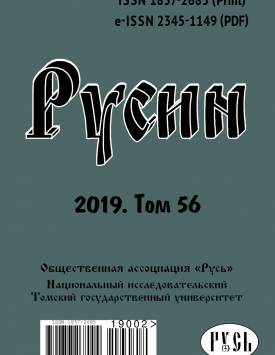Zoomorphisms as the Basis for Modelling Phraseological Semantics: Russian-Polish Equivalents
The paper analyzes the semantics of phrasemes containing zoomorphic nominations which refer to the universal metaphoric models conveying both stereotyped and nationally specific motifs of perceiving the image of an animal as applied to the characteristics of a human being. The focus is laid on the comparative analysis of zoomorphic imagery in phrasemes of related Slavic languages (namely Russian and Polish) regarded as the means of conveying East Slavic and West Slavic linguistic picture of the world. The research shows that the analyzed languages realize the unequal sets of possible meanings of polysemantic zoomorphic images. Moreover, similar thematic groups of zoomorphic nominations have discrepant connotations. The cognitive-linguistic analysis was used for distinguishing between linguistic lacunae and variable phraseological verbalizations of similar cognitions in the sphere of phraseological nominations in the languages compared. Ethnolinguistic lacunae in the sphere of zoomorphic phraseological nominations in Russian and Polish include the following: (1) Polish phrasemes with zoonyms equivalent to Russian phrasemes without zoonyms; (2) Polish phrasemes with zoonyms having no equivalent in Russian; (3) Russian non-equivalent phrasemes with zoonyms. Varible phraseological verbalizations of similar cognitions include: (1) Polish and Russian phrasemes motivated by different zoomorphisms; (2) Polish and Russian phrasemes motivated by the same zoomorphisms but having different connotations. The comparative analysis of such units in the two languages includes (1) taking into account initial presuppositions (knowledge of the habits, the way of life, the appearance, etc. of the animal); (2) taking into account the polysemy and specific connotations of zoomorphic symbols in the language; (3) defining similarities and differences both in cognitive-motivational bases for phraseological signification, and the repertoire of zoomorphic metaphors in the languages compared.
Keywords
metaphor,
phraseologism,
ethnocultural specificity,
inter-linguistic universals,
картина мира,
символика зооморфизмов,
метафора,
фразеологизм,
этнокультурная специфичность,
межъязыковые универсалии,
zoomorphic symbolism,
picture of the worldAuthors
| Gridina Tatiana A. | Ural State Pedagogical University | tatyana_gridina@mail.ru |
| Konovalova Nadezhda I. | Ural State Pedagogical University | sakralist@mail.ru |
Всего: 2
References
Müldner-Nieckowski P. Wielki słownik frazeologiczny języka polskiego: Wyrażenia, zwroty, frazy. Warszawa: Świat Książki, 2004. 1088 s.
Ting-Toomey S. Intercultural Conflict Styles: A Face-Negotiation Theory // Theories in Intercultural Communication / Y.Y. Kim, W. Gudykunst (eds). Sage, Newbury, Calif., 1988. P. 213-235.
Słownik rosyjsko-polski, polsko-rosyjski / Sergiusz Chwatow, Mikołaj Timoszuk. Toruń: Wydawnictwo REA, 2002. 646 s.
Bartmiński J. Kosmos T. I. O «Słowniku stereotipów i simboli ludowych» // Słownik stereotipów i simboli ludowych. Koncepcija całości i redakcja. Lublin: Uniwersytet Marii Curie-Składowskiej, 1996. 221 s.
Этимологический словарь славянских языков: праславянский лексический фонд. Вып. 1 (А - *besĕdьlivъ) / Под ред. О.Н. Трубачева. М.: Наука, 1974. 214 с
Устуньер И. Зооморфная метафора, характеризующая человека, в русском и турецком языках: автореф. дис. _ канд. филол. наук. Екатеринбург, 2004. 25 с
Резанова З.И. Дискурсивные картины мира // Картины русского мира: современный медиадискурс / Ред. З.И. Резанова. Томск: ИД СК-С, 2011. С. 15-94
Славянские древности: Этнолингвистический словарь: в 5 т. / Под ред. Н.И. Толстого. М.: Междунар. отношения, 2004
Огдонова Ц.Ц. Зооморфная лексика как фрагмент русской языковой картины мира: автореф. дис. _ канд. филол. наук. Иркутск, 2000. 21 с
Подгорная В.В. «Наивная анатомия» в английской языковой картине мира: автореф. дис. _ канд. филол. наук. СПб., 2016. 24 с
Лотман Ю.М. Семиосфера. СПб.: Искусство-СПБ, 2001. 704 с
Киприянова А.А. Функциональные особенности зооморфизмов (на материале фразеологии и паремиологии русского, английского, французского и новогреческого языков): автореф. дис. _ канд. филол. наук. Краснодар, 1999. 12 с
Каменская В.М. Аксиологический аспект устойчивых зооморфных сравнений и зооморфных паремий испанского языка: автореф. дис. _ канд. филол. наук. Воронеж, 2008. 18 с
Гура А.В. Муха // Славянские древности: Этнолингвистический словарь: в 5 т. / Под ред. Н.И. Толстого. М.: Междунар. отношения, 2004. Т. 3. С. 340-343
Гура А.В. Символика животных в славянской народной традиции. М.: Индрик, 1997. 912 с
Гумбольдт В. фон. Язык и философия культуры. М.: Прогресс, 1985. 448 с
Гукетлова Ф.Н. Зооморфный код культуры в языковой картине мира: на материале французского, кабардино-черкесского и русского языков: автореф. дис. _ д-ра филол. наук. М., 2009. 47 с
Гридина Т.А., Коновалова Н.И., Лундаажанцан П. Национальная специфика ассоциативного контекста зооморфной метафоры // Уральский филологический вестник. Сер. Язык. Система. Личность: Лингвистика креатива. 2018. № 2. С. 131-142
Гридина Т.А., Коновалова Н.И. Параметры лексикографической интерпретации диалектной фразеологии: лингвокультурологический аспект // Вопросы лексикографии. 2017. № 11. С. 119-131. DOI: 10.17223/22274200/11/8
Гридина Т.А. Языковая игра: стереотип и творчество. Екатеринбург: Урал. гос. пед. ун-т, 1996. 214 с
Большой фразеологический словарь русского языка. Значение. Употребление. Культурологический комментарий / Отв. ред. В.Н. Телия. М.: АСТ-Пресс книга, 2006. 784 с
Бирих А.К ., М окиенко В.М ., Степанова Л.И. Русская фразеология. Историко-этимологический словарь. М.: Астрель: АСТ: Люкс, 2005. 926 с
Бартминьский Е. Языковой образ мира: очерки по этнолингвистике. М.: Индрик, 2005. 512 с
Алефиренко Н.Ф. Фразеологическое значение: природа, сущность, структура // Грани слова: сборник научных статей к 65-летию В.М. Мокиенко. М.: ЭЛПИС, 2005. С. 21-27

